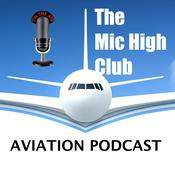Aviation News Talk – Pilot Stories, Safety Tips & General Aviation News
Max Trescott | Aviation News Talk Network

Nieuwste aflevering
Beschikbare afleveringen
5 van 408
- 407 Starting a Flight School with The Flight AcademyMax talks with John Fiscus, co-founder of The Flight Academy, and Director of Operations Jordan Ming to break down how one of the country's most respected Cirrus-focused training organizations was created, expanded, and refined over more than two decades. Whether you're an instructor considering the entrepreneurial leap, a pilot curious about how flight training businesses operate, or someone fascinated by the evolution of modern GA training, this conversation delivers clear, practical insights rooted in real experience. John opens with the origin story behind The Flight Academy—one shaped unexpectedly by the aftermath of 9/11. Before starting the company, John was an instructor and corporate pilot for Cirrus Aircraft, preparing for an airline career. When airline hiring collapsed overnight, he and colleague Luke realized they could not compete with furloughed, highly experienced pilots suddenly entering the market. But they also saw a growing demand: Cirrus owners nationwide needed instructors who truly understood their aircraft. Many local CFIs didn't yet have the expertise or avionics familiarity that early-generation Cirrus owners required. That gap created an opportunity. Instead of opening a traditional flight school with airplanes and an office, John and Luke launched The Flight Academy in 2002 with a completely different model. They owned no airplanes, no local training fleet, and no physical facility. Instead, they traveled around the country teaching owners in their own Cirrus aircraft. This approach dramatically reduced overhead while giving customers access to specialized training. What seemed unconventional at the time turned out to be the ideal way to enter the market, and demand steadily grew. As the business matured, the founders recognized the need for a home base and added a small office at Boeing Field. Eventually, they purchased their first aircraft—not a leaseback, but a nearly new Cirrus that offered strong depreciation benefits and made financial sense for the business. Today the school operates 13 aircraft across two locations—Seattle and the Portland area—supported by eight to ten instructors, depending on season and demand. About 70–80% of all hours flown at The Flight Academy are dual instruction, a reflection of their focus on high-quality training rather than simple aircraft rental volume. Jordan explains that this training-centric model shapes everything about how the business operates. The Flight Academy books training in full-day or half-day blocks, giving instructors and clients the freedom to adapt to weather, focus on deep learning, and avoid the churn of hourly scheduling. Their instructors also spend significant time traveling to clients, giving them a unique range of experience compared to CFIs who fly the same local routes every day. Many instructors make multiple coast-to-coast flights before reaching the airlines, which sets them apart in both skill and confidence. Beyond daily training, the school has diversified its business through multiple complementary revenue streams. John describes their history of Atlantic ferry flights, delivering both new and pre-owned Cirrus aircraft to Europe. He also recounts the dramatic ferry incident—captured on video—in which a malfunctioning transfer tank forced a ferry pilot to deploy the Cirrus parachute into the Pacific. That experience eventually led the team to discontinue Pacific ferrying, though they continue to complete many Atlantic deliveries. Another major offering is their Vision Jet program, which includes discovery flights, pre-type-rating preparation, and training support. Luke also works with Arista to support the Vision Jet pre-owned market, creating a powerful ecosystem that blends aircraft sales, owner transitions, and specialized instruction. Jordan emphasizes that this interlocking structure allows the team to provide a seamless experience for owners, from first flight through long-term advanced training. Perhaps the most distinctive part of The Flight Academy's identity is their adventure trips—all-inclusive guided flying experiences to destinations such as Alaska, Morocco, the Caribbean, Europe, and New England during fall foliage season. These trips sell out consistently and create long-lasting friendships among participating owners. Jordan notes that many pilots appreciate having experts plan the hotels, customs logistics, activities, and daily flight legs—allowing them to simply enjoy the journey and the aircraft. When it comes to hiring CFIs, John is clear: "We don't hire pilots. We hire teachers." A strong instructor mindset matters more than flight time or ratings. He looks for individuals who demonstrate genuine interest in the business, a thoughtful approach to training, and the professionalism needed to work with sophisticated clients. He also shares hard-earned lessons about policies, cancellations, contracts, and pricing—key areas where many new flight school owners struggle. The episode closes with candid advice for CFIs considering launching their own school. Jordan stresses the importance of accepting that owners will fly less and manage more, while John encourages thoughtful planning and learning from others who have successfully done it. Their message is hopeful but realistic: starting a flight school is absolutely possible if you approach it with a solid plan, a clear mission, and a commitment to delivering exceptional training. If you're getting value from this show, please support the show via PayPal, Venmo, Zelle or Patreon. Support the Show by buying a Lightspeed ANR Headsets Max has been using only Lightspeed headsets for nearly 25 years! I love their tradeup program that let's you trade in an older Lightspeed headset for a newer model. Start with one of the links below, and Lightspeed will pay a referral fee to support Aviation News Talk. Lightspeed Delta Zulu Headset $1199 HOLIDAY SPECIALNEW – Lightspeed Zulu 4 Headset $1099 Lightspeed Zulu 3 Headset $849 HOLIDAY SPECIALLightspeed Sierra Headset $749 My Review on the Lightspeed Delta Zulu Send us your feedback or comments via email If you have a question you'd like answered on the show, let listeners hear you ask the question, by recording your listener question using your phone. Mentioned on the ShowBuy Max Trescott's G3000 Book Call 800-247-6553 The Flight Academy flight school Cirrus SR22 Parachute Pull near Hawaii Check out our recommended ADS-B receivers, and order one for yourself. Yes, we'll make a couple of dollars if you do. So You Want To Learn to Fly or Buy a Cirrus seminars Online Version of the Seminar Coming Soon – Register for Notification Check out Max's Online Courses: G1000 VFR, G1000 IFR, and Flying WAAS & GPS Approaches. Find them all at: https://www.pilotlearning.com/ Social Media Like Aviation News Talk podcast on Facebook Follow Max on Instagram Follow Max on Twitter Listen to all Aviation News Talk podcasts on YouTube or YouTube Premium "Go Around" song used by permission of Ken Dravis; you can buy his music at kendravis.com If you purchase a product through a link on our site, we may receive compensation.--------53:57
- 406 Flying Tails: Ken Wayne's Amazing Animal Rescue Flights with Bears, Eagles & WildlifeMax talks with former KTVU 2 and KRON 4 anchor Ken Wayne, founder of Flying Tails, about his extraordinary animal rescue flights involving bear cubs, bald eagles, coyotes, and dozens of shelter animals across California. Drawing on his past experience as a Navy journalist, Ken describes the path that led him from military broadcasting to a major-market news career—and ultimately to a mission that blends aviation with wildlife rescue. Ken's journey began at the Navy's Defense Information School, where he learned print reporting, photography, radio, and TV production. His service assignments took him from the Aleutian Islands to the Mediterranean aboard the USS Biddle, and finally to Subic Bay in the Philippines, where he hosted a radio show and shot television stories for the Far East Network. He also frequently traveled by helicopter and even completed a carrier landing in a COD aboard USS Midway, building a deep appreciation for aviation. Years later, after buying a Cessna 182 and flying with friends, Ken discovered animal rescue missions through Pilots N Paws. His breakthrough came when he responded to a call seeking transport for two bear cubs from South Lake Tahoe to Ramona. That flight—completed the day before a long-planned trip to Paris—set the tone for what Flying Tails would become. The TV story went viral, helped earn him an award from the U.S. Humane Society, and brought new awareness to the potential of using GA aircraft for wildlife operations. Since then, Flying Tails has become California Fish & Wildlife's go-to aviation nonprofit. Ken describes rescuing seven bear cubs in one summer, including a tiny Ventura County cub that had to be bottle-fed by caregivers wearing bear suits to prevent human imprinting. That cub later lived in a world-class bear enclosure in Sonoma County before returning to the wild near Ojai. Another cub, found hairless in the El Dorado National Forest, was flown to the Sequoia Park Zoo after it was deemed unfit for winter survival. Flying Tails also rescues countless cats and dogs from overwhelmed Central Valley shelters. Ken recounts missions involving 21 animals at once—14 puppies found in a garbage bag, kittens injured in a tent fire, and dozens of animals who were mere hours away from being euthanized due to lack of space. He explains why animals move northward in California, where adoption demand is higher and shelter capacity more manageable. The organization's wildlife work includes transporting owls, hawks, raptors, and a bald eagle Ken released at Lake Almanor—a moment he describes as one of the most exhilarating of his life. Wildlife crates are lined with burlap to prevent feather damage, and after each flight, aircraft are disinfected to prevent disease transmission. Gloves, tie-downs, and careful weight-and-balance planning are essential parts of every mission. Emotionally, Ken says what keeps him going is watching animals shed their fear during flight. Many board the airplane scared, panting, or stressed from heat, only to fall asleep within 20–30 minutes at altitude. When the airplane lands in cooler Bay Area air, the animals appear visibly relieved. That shift—from fear to calm—is what Ken believes makes these missions so rewarding for pilots. Flying Tails is expanding rapidly. Ken recently premiered the first episode of his new PBS series Flying Tales, available on the PBS app, showcasing these missions and the beauty of California from the air. His long-term vision is to establish Flying Tails bases nationwide, enabling wildlife flights for sea turtles, alligators, wolves, and more. Pilots interested in joining the mission can sign up at FlyingTails.org or reach Ken directly. If you're getting value from this show, please support the show via PayPal, Venmo, Zelle or Patreon. Support the Show by buying a Lightspeed ANR Headsets Max has been using only Lightspeed headsets for nearly 25 years! I love their tradeup program that let's you trade in an older Lightspeed headset for a newer model. Start with one of the links below, and Lightspeed will pay a referral fee to support Aviation News Talk. Lightspeed Delta Zulu Headset $1199 HOLIDAY SPECIALNEW – Lightspeed Zulu 4 Headset $1099 Lightspeed Zulu 3 Headset $949Lightspeed Sierra Headset $749 My Review on the Lightspeed Delta Zulu Send us your feedback or comments via email If you have a question you'd like answered on the show, let listeners hear you ask the question, by recording your listener question using your phone. Mentioned on the ShowBuy Max Trescott's G3000 Book Call 800-247-6553 Video of the Week: Episode #1 of Flying Tails television show Flying Tails website Flying Tails Facebook page Check out our recommended ADS-B receivers, and order one for yourself. Yes, we'll make a couple of dollars if you do. So You Want To Learn to Fly or Buy a Cirrus seminars Online Version of the Seminar Coming Soon – Register for Notification Check out Max's Online Courses: G1000 VFR, G1000 IFR, and Flying WAAS & GPS Approaches. Find them all at: https://www.pilotlearning.com/ Social Media Like Aviation News Talk podcast on Facebook Follow Max on Instagram Follow Max on Twitter Listen to all Aviation News Talk podcasts on YouTube or YouTube Premium "Go Around" song used by permission of Ken Dravis; you can buy his music at kendravis.com If you purchase a product through a link on our site, we may receive compensation.--------53:26
- 405 Aviation Safety Lessons from Todd Conklin: Human Factors, Margin & MistakesIn this episode of Aviation News Talk, we begin with the developing details In this episode of Aviation News Talk, Max sits down with renowned safety expert Dr. Todd Conklin to explore some of the most important aviation safety lessons pilots can learn from Human & Organizational Performance (HOP)—a framework rooted in human factors, systems thinking, and the realities of how people actually perform in complex environments. Todd's work has shaped safety programs across multiple high-risk industries, and in this episode he explains how these ideas translate directly to aviation, both for professional pilots and general aviation flyers. Todd begins by reframing how pilots should think about safety. Safety is not a static condition or something you "have" because you passed a checkride; instead, safety is a capacity, similar to fuel, that must be built, protected, and constantly replenished. This capacity includes time to think, margin for error, resilience, and the ability to recover when something goes wrong. When pilots allow that capacity to shrink—through rushed planning, complacency, or pressure—they lose the very buffer that keeps small mistakes from becoming accidents. Max and Todd dive into the first HOP principle: people make mistakes. This simple truth is foundational in human factors but often overlooked in aviation culture. Many pilots implicitly believe that if they just try hard enough, they can deliver perfect performance, yet every flight includes small deviations and errors. The key isn't eliminating mistakes—it's ensuring the system has enough margin so those mistakes don't cascade into failures. This leads to the second principle: blame fixes nothing. Todd explains that blaming pilots for errors obscures the real question: What conditions made that mistake possible? Max shares an example from a flight club where an accident prompted a search for someone to blame. Todd counters that meaningful safety improvement comes from understanding system interactions rather than assigning fault. They then discuss the third HOP principle, learning is vital. High-reliability organizations routinely debrief their successes—not just failures—because the same system dynamics that allow a successful flight may also allow a failure under slightly different conditions. Todd notes that curiosity is one of a pilot's most important safety tools; pilots who continuously seek to understand their environment develop stronger mental models and better decision-making under pressure. The conversation then moves into one of the most powerful HOP principles: context drives behavior. Todd explains that people behave differently depending on the setting, expectations, and formality of the environment. Airline pilots operate within a highly formalized culture—uniforms, checklists, cockpit procedures, and CRM—that creates predictable behavior and reduces variability. GA pilots, by contrast, have to formalize their own environment, since they don't benefit from the same structure. Simple habits, like always dressing appropriately, using a structured briefing, or maintaining personal minimums, help create a context that supports safer flying. Finally, Todd discusses the last major HOP principle: how leaders respond matters. For pilots, this includes how they respond to their own errors, near-misses, and close calls. Near-misses, Todd says, are "gifts"—accidents without consequences—that provide an ideal opportunity to identify weak controls or missing margin. He distinguishes between near-miss good, where robust controls allowed recovery, and near-miss lucky, where the pilot simply avoided disaster by chance. Both are important signals, and both must be studied with honesty and without blame. Todd brings these concepts to life with vivid examples, including his well-known "Kenny the Alligator Wrestler" story and his experience working with Admiral John Meyer and the U.S. Navy's aircraft carrier operations. Through cross-training, structured practice, and better system understanding, the Navy dramatically reduced ground-handling incidents on carrier decks—reinforcing how resilience and margin must be intentionally built into high-risk operations. Max and Todd close by emphasizing that aviation safety advances through learning, innovation, curiosity, and margin, not perfection. For pilots, this means consistently planning ahead, making conservative decisions, building buffer into every phase of flight, and embracing the idea that mistakes are inevitable—but accidents don't have to be. This episode equips pilots with a deeper understanding of human factors, risk management, and the practical application of HOP principles, offering a richer, more realistic framework for staying safe in today's increasingly complex flying environment. If you're getting value from this show, please support the show via PayPal, Venmo, Zelle or Patreon. Support the Show by buying a Lightspeed ANR Headsets Max has been using only Lightspeed headsets for nearly 25 years! I love their tradeup program that let's you trade in an older Lightspeed headset for a newer model. Start with one of the links below, and Lightspeed will pay a referral fee to support Aviation News Talk. Lightspeed Delta Zulu Headset $1199 HOLIDAY SPECIALNEW – Lightspeed Zulu 4 Headset $1099 Lightspeed Zulu 3 Headset $949Lightspeed Sierra Headset $749 My Review on the Lightspeed Delta Zulu Send us your feedback or comments via email If you have a question you'd like answered on the show, let listeners hear you ask the question, by recording your listener question using your phone. Mentioned on the ShowBuy Max Trescott's G3000 Book Call 800-247-6553 Video of the Week: Kenny the Alligator Wrestler Dr. Todd Conklin's website Dr. Conklin's book: Pre-Accident Investigations Dr. Todd Conklin's podcast: Pre-Accident Investigations Check out our recommended ADS-B receivers, and order one for yourself. Yes, we'll make a couple of dollars if you do. So You Want To Learn to Fly or Buy a Cirrus seminars Online Version of the Seminar Coming Soon – Register for Notification Get the Free Aviation News Talk app for iOS or Android. Check out Max's Online Courses: G1000 VFR, G1000 IFR, and Flying WAAS & GPS Approaches. Find them all at: https://www.pilotlearning.com/ Social Media Like Aviation News Talk podcast on Facebook Follow Max on Instagram Follow Max on Twitter Listen to all Aviation News Talk podcasts on YouTube or YouTube Premium "Go Around" song used by permission of Ken Dravis; you can buy his music at kendravis.com If you purchase a product through a link on our site, we may receive compensation.--------59:08
- 404 VFR into IMC: Why GA Pilots Crash in Weather and How to Stay VFR + GA NewsIn this episode of Aviation News Talk, we begin with the developing details Weather accidents in general aviation often happen to pilots who genuinely believe they're cautious about flying in marginal conditions. But when you look closely at the chain of decisions that lead up to VFR-into-IMC crashes, a consistent pattern emerges—fatigue, long flights, pressure to complete a trip, weakening visibility, and the belief that "I can stay just under this." In Episode 404 of Aviation News Talk, Max Trescott unpacks a tragic example of this pattern and shows how NTSB data helps explain why GA pilots continue to stumble into weather accidents. Max begins with a detailed look at a 2023 crash involving a Piper Archer, N21480, flown by a 66-year-old private pilot who was en route from Maine to Sun 'n Fun. The pilot had made this long trip multiple times before and was familiar with the route. He departed Maine, stopped twice for fuel, and ended the day by sleeping on a couch in a pilot lounge—after ordering Uber Eats at around 8 p.m. According to his wife, the pilot routinely camped at airports, carried sleeping gear and guitars, and prided himself on being cautious about weather. The next morning, however, the signs of fatigue were visible. An airport employee who spoke with the pilot noted he looked tired and "could see the fatigue in his eyes." Despite checking weather and considering waiting out an approaching system, the pilot ultimately chose to depart. He told ATC he wanted to remain low—around 1,600 feet—to stay VFR under the cloud layer. Unfortunately, this strategy is one of the most dangerous choices a VFR pilot can make. Staying low reduces options, shrinks reaction time, and increases the likelihood of inadvertently entering IMC. Eight minutes after informing ATC he wanted to stay low to maintain VFR, the pilot's track shows the airplane turning right and descending. When the controller asked if he was maneuvering to stay below the clouds, the pilot replied: "Mayday, mayday, in the clouds, I'm going down." Witnesses described the airplane descending nearly straight down. The NTSB report revealed worsening weather, nearby convective activity, cloud bases around 1,300 feet AGL, and an overcast layer with tops near 3,500 feet. The pilot had passed an airport less than two miles before the crash—an airport he may have been trying to return to during his final 360-degree turn. But like many non-instrument-rated pilots who enter IMC unintentionally, he lost control within about a minute, consistent with studies showing that VFR pilots often lose control within three minutes of entering clouds. Max then connects this accident to a broader NTSB study, Risk Factors Associated with Weather-Related General Aviation Accidents (SS-05/01). This landmark analysis compared 72 weather-related accidents with 135 non-accident flights occurring nearby at the same time. The goal was to uncover what differentiates pilots who get into trouble from those who do not. The results were eye-opening. The most significant predictor was the age at which a pilot earned their first certificate, not their age at the time of the accident. Pilots who learned to fly at age 25 or younger had the lowest risk. Those who trained between 25 and 35 had a 4.5-times higher risk, between 35 and 45 had a 4.8-times higher risk, and pilots who started at 45 or older had a 3.4-times higher risk. The South Carolina pilot earned his certificate at around age 49. Another major factor was lack of an instrument rating. Non-instrument-rated pilots had a 4.8-times greater likelihood of a weather accident. Long flights were also a major contributor: legs of 300 miles or more sharply increased risk. Pilots involved in accidents were less likely to have obtained thorough weather briefings and more likely to have had previous incidents or accidents. One of the most striking findings concerned written and checkride performance. Accident pilots had cumulative pass rates averaging 84–86%, while non-accident pilots averaged around 95%. Some accident pilots had multiple failed checkrides, including one commuter pilot who had failed nine practical tests. The study concluded that stronger written and checkride performance was statistically linked to lower accident involvement. From there, Max shifts to what pilots can do differently, starting with awareness. Humans are poor at detecting gradual reductions in visibility—the "frog in warm water" problem. Max describes an early flight to Massachusetts where visibility slowly degraded from 25 miles to around 10 miles, yet he didn't notice until the change became obvious. To counter this, he recommends periodically estimating visibility in flight using runway lengths, moving-map distances, landmarks, and horizon clarity. Max also teaches a simple method for estimating cloud clearance using a 45-degree reference point on the cloud base. By timing how long it takes to reach the point beneath the cloud and using your groundspeed, you can determine if you're maintaining the required 500-foot clearance. The same geometry works for estimating horizontal cloud distance. Finally, Max emphasizes fatigue and decision-making. After nearly 10 hours of flying the day before, poor sleep on a couch, and an early morning departure, the pilot in the accident was not at peak performance. Nutrition also matters—low glucose levels degrade decision-making. Max stresses the need to set clear weather trigger points before departure, brief passengers on them, and stick to the plan. For any pilot who flies VFR, especially on long cross-country trips, this episode highlights why VFR-into-IMC accidents still happen—and how to stay VFR by using better judgment, better tools, and objective visibility cues. If you're getting value from this show, please support the show via PayPal, Venmo, Zelle or Patreon. Support the Show by buying a Lightspeed ANR Headsets Max has been using only Lightspeed headsets for nearly 25 years! I love their tradeup program that let's you trade in an older Lightspeed headset for a newer model. Start with one of the links below, and Lightspeed will pay a referral fee to support Aviation News Talk. Lightspeed Delta Zulu Headset $1199 HOLIDAY SPECIALNEW – Lightspeed Zulu 4 Headset $1099 Lightspeed Zulu 3 Headset $949Lightspeed Sierra Headset $749 My Review on the Lightspeed Delta Zulu Send us your feedback or comments via email If you have a question you'd like answered on the show, let listeners hear you ask the question, by recording your listener question using your phone. News Stories Successful Parachute Pulls Hurricane Relief Flight Crashes in Florida General Aviation Adapts as FAA Adjusts Restrictions Fire Destroys Three Aircraft at Avon Park, Florida Hawker accident pilots chose not to wait for a test pilot Pilot presses wrong lever in unfamiliar plane N59BR, Challenger 1 experimental aircraft rudder pedals crash Joby Tests Military Hybrid VTOL Helicopter pilot pleads guilty in 2021 TN crash that killed passenger New Details on Alaska Airlines Pilot Who Tried To Kill Engines Mid-Flight Mentioned on the ShowBuy Max Trescott's G3000 Book Call 800-247-6553 Max's FLYING Column on use of the Autopilot APR key Free Index to the first 282 episodes of Aviation New Talk So You Want To Learn to Fly or Buy a Cirrus seminars Online Version of the Seminar Coming Soon – Register for Notification Check out our recommended ADS-B receivers, and order one for yourself. Yes, we'll make a couple of dollars if you do. Get the Free Aviation News Talk app for iOS or Android. Check out Max's Online Courses: G1000 VFR, G1000 IFR, and Flying WAAS & GPS Approaches. Find them all at: https://www.pilotlearning.com/ Social Media Like Aviation News Talk podcast on Facebook Follow Max on Instagram Follow Max on Twitter Listen to all Aviation News Talk podcasts on YouTube or YouTube Premium "Go Around" song used by permission of Ken Dravis; you can buy his music at kendravis.com If you purchase a product through a link on our site, we may receive compensation.--------55:01
- 403 UPS MD-11 Crash Analysis + Dr. Catherine Cavagnaro on How to Make Better LandingsIn this episode of Aviation News Talk, we begin with the developing details surrounding the crash of UPS Airlines Flight 2976, a McDonnell Douglas MD-11F cargo aircraft that crashed shortly after takeoff from Louisville, Kentucky. The aircraft, tail number N259UP, was a 34-year-old MD-11F powered by three General Electric CF6-80 engines. Bystander video shows the left engine separated from the wing, with the wing engulfed in flames as the aircraft lifted off. ADS-B data indicates the aircraft climbed less than 100 feet before beginning a descending, left-turning roll from which it did not recover. The crew had already passed V1, meaning they were committed to takeoff and did not have adequate runway remaining to stop. In situations like this, flight crews may have no survivable option, and this accident may represent one of those rare but tragic scenarios. We also compare aspects of this event to American Airlines Flight 191, the 1979 DC-10 crash at Chicago O'Hare. While both accidents involved the loss of the left engine on takeoff, the failure chain in AA191 involved slat retraction due to damaged hydraulic and control lines—failure modes later addressed in the MD-11 design. The MD-11's slats are hydraulically locked to prevent unintended retraction, meaning the probable cause of this accident must differ in critical ways. After the accident analysis, we shift to a practical, pilot-focused conversation about landings with returning guest Dr. Catherine Cavagnaro, columnist for AOPA and highly respected flight instructor and DPE. Drawing on more than a thousand check rides, Catherine explains that the most consistent problem she sees is pilots flying final approach too fast. While pilots often worry about being too slow, the data shows that excessive approach speed is far more common and contributes to long landing rolls, excessive float, bounced landings, and pilot-induced oscillations. Catherine and Max discuss how a correct approach speed provides the right amount of energy to land smoothly and in control. More power and speed make it harder to manage the flare and to touch down where intended. Pilots also frequently fail to align the aircraft longitudinal axis with the runway before touchdown, particularly in crosswinds, due to hesitation in applying sufficient rudder and aileron. Catherine explains that as the aircraft slows, flight controls become less effective, so pilots should expect to use more control input in the final seconds before touchdown—not less. The conversation also explores landing accuracy, noting that pilots should strive to touch down within 200–400 feet of a target point—not "somewhere down the runway." Even on long runways, building accuracy pays dividends when landing at shorter fields or during check rides. A useful data tool Catherine recommends is FlySto (flysto.net), which allows pilots with modern avionics to upload flight data and analyze approach speed, pitch attitude, touchdown point, crab angle, rollout direction, and braking forces. By reviewing objective data, pilots can identify habits and improve their consistency over time. Whether you're teaching new pilots, returning to flying after a break, or simply want your landings to be more stable and predictable, Catherine's techniques offer actionable steps: choose the correct approach speed, use proper crosswind controls, flare to a nose-high attitude, and maintain precision with touchdown point selection. Together, the accident analysis and the landing discussion reinforce a core theme of this show: aviation skills improve with deliberate practice, continuous learning, and a deep respect for the realities of risk, energy management, and aircraft control. If you're getting value from this show, please support the show via PayPal, Venmo, Zelle or Patreon. Support the Show by buying a Lightspeed ANR Headsets Max has been using only Lightspeed headsets for nearly 25 years! I love their tradeup program that let's you trade in an older Lightspeed headset for a newer model. Start with one of the links below, and Lightspeed will pay a referral fee to support Aviation News Talk. Lightspeed Delta Zulu Headset $1199 HOLIDAY SPECIAL NEW – Lightspeed Zulu 4 Headset $1099 Lightspeed Zulu 3 Headset $949Lightspeed Sierra Headset $749 My Review on the Lightspeed Delta Zulu Send us your feedback or comments via email If you have a question you'd like answered on the show, let listeners hear you ask the question, by recording your listener question using your phone. News Stories UPS MD-11 crashed almost after takeoff from Louisville airport FAA is set to start cutting flights to contend with delays and staffing shortages Archer Buys LA-Area Airport Jeppesen ForeFlight Unified Under Private Equity Ownership FAA acknowledges BasicMed form error Pilot injured when Piper hits fence Extreme turbulence bends Cessna 152 Blade to Launch Weekday Commuter Flights Between Manhattan and Westchester Mentioned on the ShowAmerican Airlines Flight 191 Analysis by Jeff Guzzetti Fly California Passport Program Catherine Cavagnaro YouTube Channel Ace Aerobatic School Buy Max Trescott's G3000 Book Call 800-247-6553 Free Index to the first 282 episodes of Aviation New Talk So You Want To Learn to Fly or Buy a Cirrus seminars Online Version of the Seminar Coming Soon – Register for Notification Check out our recommended ADS-B receivers, and order one for yourself. Yes, we'll make a couple of dollars if you do. Get the Free Aviation News Talk app for iOS or Android. Check out Max's Online Courses: G1000 VFR, G1000 IFR, and Flying WAAS & GPS Approaches. Find them all at: https://www.pilotlearning.com/ Social Media Like Aviation News Talk podcast on Facebook Follow Max on Instagram Follow Max on Twitter Listen to all Aviation News Talk podcasts on YouTube or YouTube Premium "Go Around" song used by permission of Ken Dravis; you can buy his music at kendravis.com If you purchase a product through a link on our site, we may receive compensation.--------1:04:32
Meer Vrije tijd podcasts
Trending Vrije tijd -podcasts
Over Aviation News Talk – Pilot Stories, Safety Tips & General Aviation News
General Aviation news, pilot tips for beginners & experts, interviews, listener questions answered, technical details on G1000 & Perspective glass cockpits & flying GPS approaches. 40 yrs experience flying general aviation aircraft. As an active flight instructor, I bring my daily experiences in the air to this show to help teach pilots and future pilots to fly safely. I'm a Platinum Cirrus CSIP instructor and work with people who are thinking about buying a new or used SR20 or SR22. Go to AviationNewsTalk.com for my contact information, or to click on Listener Questions, which lets you speak into your phone to leave a question you'd like answered on the show.
Podcast websiteLuister naar Aviation News Talk – Pilot Stories, Safety Tips & General Aviation News, Ron en Erik Podcast en vele andere podcasts van over de hele wereld met de radio.net-app

Ontvang de gratis radio.net app
- Zenders en podcasts om te bookmarken
- Streamen via Wi-Fi of Bluetooth
- Ondersteunt Carplay & Android Auto
- Veel andere app-functies
Ontvang de gratis radio.net app
- Zenders en podcasts om te bookmarken
- Streamen via Wi-Fi of Bluetooth
- Ondersteunt Carplay & Android Auto
- Veel andere app-functies


Aviation News Talk – Pilot Stories, Safety Tips & General Aviation News
Scan de code,
download de app,
luisteren.
download de app,
luisteren.





































